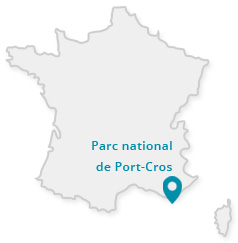
Porquerolles
Port-Cros
Faune terrestre
The diet of the Black Rat from three islands (Port-Cros, Porquerolles and Bagaud, South-East France) was studied using stomach content and stable carbon and nitrogen isotope analysis.
The results show that plant matter is present in winter in 71 % to 88 % of the analysed stomachs, depending on the island. In volume, leaves (17 species) account for 33,5 % of the stomach contents, fruits (7 species) 26,7 %, and seeds 8,53 %. Two species (Smilax aspera and Juniperus phoenicea) are the more commonly ingested, both in volume and in frequency. Each stomach shows numerous items in very small amount (less than 1 % of the total volume). Thereupon Cistus leaves, although frequently observed (19 stomachs out of 25), make up only 0,33 % of the volume of the diet. Animal matter (Arthropods), present in 0,7 % to 11 % of the stomachs, is much less frequent, accounting for 3,4 % of the volume.
Isotopic biochemistry analysis of rat hair and faeces does not show different results: on Port-Cros island, when the δ13C and δ15N signatures are plotted together with rat hair, it appears a mixed diet where plants and terrestrial Arthropods constitute the staple content in summer. Neither birds nor marine molluscs seem to be predated. This pattern is similar to that of Porquerolles island, although plants seem more frequently eaten there. Both types of analysis have failed to reveal a predation on seabird colonies in the islands studied.
| Auteurs | CASSAING,Jacques; DERRÉ, Cécile; MOUSSA, Issam |
|---|---|
| Éditeur | Parc national de Port-Cros |
| Nombre de pages | 27 |
| Référence | 2005 - 21 : 89-115 |


